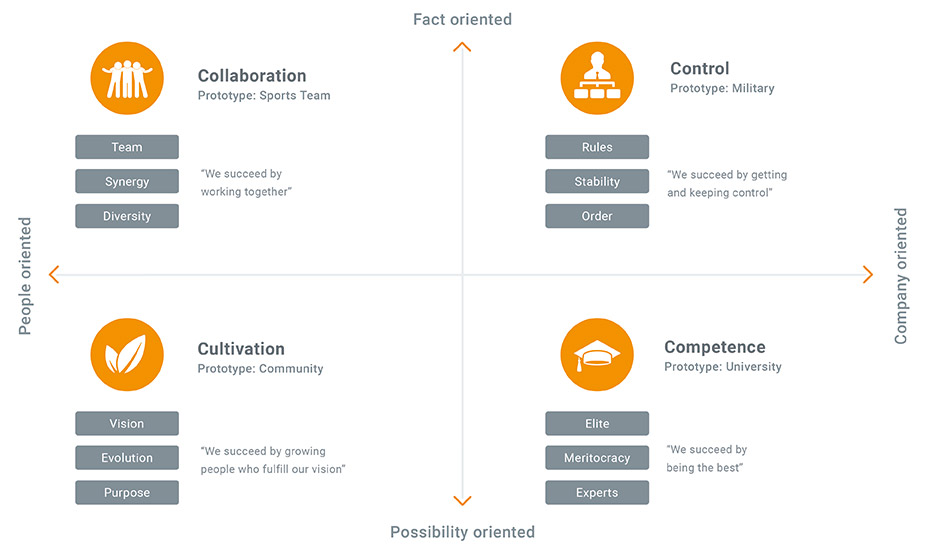Get in touch
The German national daily newspaper “Die Süddeutsche Zeitung” describes it as managing Post-it notes. Others think that it is sufficient to implement “Scrum” or “Design Thinking”. We are talking about agile work. But what does that mean in concrete terms? How can companies avoid getting bogged down during implementation? And what do they have to pay special attention to in economically challenging times deeply affected by the Corona crisis? New insights can help us to rethink a familiar mindset.
Agile work processes as we know them today, have their origin in the 1990s and are closely linked to software development. Since the beginning of the new millennium, the “Manifesto for Agile Software Development” lists the most important principles. The four guiding principles are:

Working in an agile manner does not only mean developing software in an agile way. It is much more. On the one hand, it's about collaboration - with each other and with the customer. On the other hand, it is about flexibility - with regard to processes and changes. And it's about jointly finding solutions to the customer's problems.
Agility refers to a form of work organization whose objectives are, in particular, adaptability, agility and rapid, proactive response to changes in individuals and organizations. The term is applied to both structures and work processes. Agile working methods are particularly suited to react to complex situations and challenges and are therefore not only applicable to software development - here agility means rapid development in short iterative cycles (sprints). Through regular delivery of functioning software, added value is created early on, necessary changes can be identified and implemented at an early stage. Regular communication and transparency are important characteristics of agile organizations. An agile approach is particularly useful in complex environments, as unexpected changes often occur that require adjustments.
However, for work to be agile, the company itself must also be agile. In other words: An agile corporate culture is the basic prerequisite for successful agile work with the necessary mindset of: “How I think influences my attitude and I act accordingly!”
As mentioned above, these concepts – together with the accompanying mindset – are not new. However, in light of the current events, they gain a very specific sense of urgency, as agility can be a useful counter to the economic impact of the worldwide Corona pandemic.
There are numerous models for companies that show what a successful agile corporate culture can look like. Many aspects of the culture are taken into account, including the best possible development of employees, fostering initiative and self-organization, as well as a value-adding, partnership-based relationship with customers.
A particularly promising model is the “Culture Model” according to William E. Schneider (“The Reengineering Alternative”). Schneider describes corporate culture as “How we do things around here in order to succeed.” For Schneider, organizational culture is closely linked to the way companies are led (Leadership) and with the ideas management has about how things in the company are supposed to work. He divides his model into four separate cultures:
The cultures are arranged in quadrants of a matrix (Fig. 1) with the axes decision orientation and value orientation. The decision orientation axis scrutinizes how a company makes decisions. This can occur people-oriented (i.e. self-determined, evolutionary, unconventional and considerate) or company-oriented (i.e. formal, without emotion, fact-based and principled). In value orientation, the question is asked what a company attaches particular importance to. On the one hand, this can be possibility-oriented, which means that a company acts out of conviction and pays attention to innovation, opportunities and inspiration. Or this can be reality-oriented. Here, the company emphasizes actual conditions, facts, previous experience and utility.

In agile companies, the emphasis is on collaboration; success is based on the teamwork of employees who follow a common entrepreneurial vision.
To ensure this success, agile employees must be able to work and make decisions in a team in a self-determined and responsible manner. Therefore, an agile company must entrust its employees with a high degree of personal responsibility, self-management and freedom of decision. Only in this way are agile teams capable of leading themselves and creating added value for customers. This pays off on the mindset of attitude and action mentioned above. When applied to the current crisis, self-managed, responsible teams are able to react much faster than traditional companies, organized in strict hierarchies.
But what does agility look like in practice? An example from the financial sector shows the advantages of this approach. Commerz Real, a wholly-owned subsidiary of Commerzbank, wanted to expand its product range while establishing agile processes at the same time. To this end, it commissioned AOE to develop a solution for the automated, digital calculation of leasing contracts for moveable assets. AOE develops digital business, E-Commerce and marketplace solutions. In addition, AOE supported Commerz Real in its transformation to agile, future-oriented project implementation processes. In the spirit of agility, Commerz Real's local teams were empowered to make decisions. Dr. Andreas Muschter, CEO of Commerz Real, describes the impact agile work processes had on the project: “Agility became second nature to our employees. I often thought that ‘they could have occasionally asked me something.’ But they simply decided to act the way they did because they said they were the best judge of the situation anyway. ‘We want to be quick. We don’t want to waste time. That’s why we’re doing it this way.’"
For agile teams to be able to work productively, the appropriate underlying conditions must be defined in advance. This includes resources (team size and expertise), time, technologies used and budget. If these parameters are in place, agile teams can work independently.
This was also the case at Commerz Real. As a result, the time-to-market was much shorter when developing the solution than would have been the case with a non-agile methodology. In 2018, Commerz Real was honored by the European Real Estate Brand Institute as the company with the highest digitalization competence in the real estate industry.
In the second part of this blog series, I will discuss the differences between traditional and agile companies, explain the three basic requirements for agility and give an overview of the Tuckman phase model of group development.
Further insights into the topic and how agility can be implemented in companies can be found in parts two and three of this blog series:
This blog post is an excerpt of the article “So geht agil: Ein Bauplan für jedes Unternehmen”, which originally appeared in German on ibusiness.